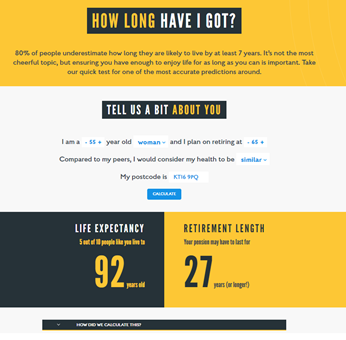The 8-year gap - an understanding issue we mustn’t ignore
19 May 2022
An individual’s longevity has a number of different drivers: their health, their lifestyle, their affluence and even their family history (although not as much as often thought, other studies have revealed). Recent research from international longevity experts Club Vita has identified a significant gap in people’s appreciation of how long they are likely to live for. This can have major financial consequences in their planning for retirement.
Club Vita’s survey asked the morbid but important question – how long do you think you will live? The results were compared with Vita’s calculated life expectancy based on their own models which are as granular as down to the street you live in!
The results were stark. On average men in the UK under-estimate how long they will live for by 3.4 years. For women it was a staggering 7.9 years. If they were to stop work at age 65, this underestimation in life expectancy would account for around a third of their retired life (in fact, when asked, men and women both said they plan to stop work at the even earlier age of 63).
This has significant consequences for:
- Early life savings strategy – how long you need your money to last for informs how much you need to save today, while there is time to do something about it;
- Retirement spending rates – retirement spending plans will need to reflect how long you will need it for as well as how much you need;
- Product decisions – making the right choice around annuity, DB guarantees, lifetime mortgage and drawdown could be worth £10ks or £100ks to many people;
- Financial advice – the FCA is increasingly focusing on longevity risk as well as investment risk, something advisors will need to factor in accordingly.
Average figures are useful for understanding the systematic trends in experience of large groups, however there will be large variations in how long people will actually live, with many living longer lives than the average and many living shorter lives. While for any individual the chance of dying at your predicted life expectancy is just 4%, overall far more people will live longer than they have financially prepared for.
As an industry, we are in a good position to meet this challenge. The data now exists to adopt more specific longevity estimates for a given customer without the need for lengthy questionnaires or intrusive and expensive medical processes. Simple digital tools can be provided to help people understand this.

Stochastic modelling allows us to assess the likelihood of someone running out of money across a range of different product choice and spending strategies, allowing us to optimise and provide digital advice on how to proceed.
And financial advisors can use the data to have a more valuable conversation with their clients around the likely length of time they need their income to last.
Starting with 1,000 people the same age, gender, postcode and health status the chart shows how many are expected to still be alive at each age to 100

To access the full research including comparison with the US and Canada click here.



0 comments on this post